Brass vs Rubber Violin Mute: Which One is Better for Practice?
Brass vs rubber violin mute, this choice matters more than you might think. If you’re trying to practice quietly without losing your tone, picking the right mute can make a big difference. It changes how your violin sounds, how it feels, and even how well you improve over time.
A brass mute and a rubber mute both lower sound, but they don’t affect your violin in the same way. They change the tone, how your bow feels, and even the balance of your violin.
Here you will learn:
- What really changes in your sound with each mute?
- Does one mute protect your technique better than the other?
- Which is more practical for everyday use?
- What do pros and teachers recommend?
Let’s break this down clearly and practically.
Brass vs Rubber Violin Mute: A Quick Comparison
Here’s a side-by-side breakdown of the key differences between brass and rubber mutes:
| Feature | Brass Mute | Rubber Mute |
|---|---|---|
| Material | Solid brass (metal) | Flexible rubber |
| Volume Reduction | High – very quiet | Moderate – quieter but not silent |
| Tone Quality | Dark, compressed, less natural | Warm, soft, closer to natural tone |
| Weight | Heavy, can affect balance | Light, no major impact |
| Instrument Safety | Can damage bridge if dropped | Safe and gentle on bridge |
| Ideal For | Apartments, hotels, late-night practice | Tone work, daily practice, student use |
How Do Brass and Rubber Mutes Work Differently on a Violin?
When considering the choice between a brass vs rubber violin mute, it’s important to understand that both do the same basic job: they reduce the violin’s volume. But how they do it, and the way they change your sound, is very different.
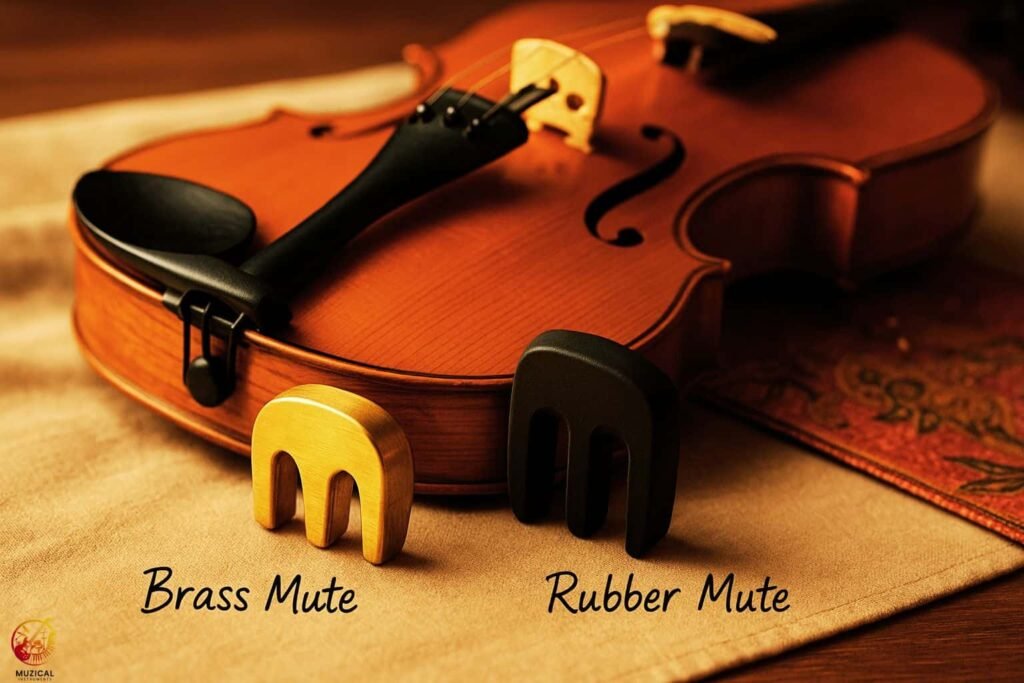
A brass mute is heavy and made of metal. When it sits on the bridge, it absorbs and redirects a lot of the vibration that would normally travel through the violin body. That gives a much quieter, darker, and more compressed sound.
A rubber mute, on the other hand, is lighter and softer. It doesn’t absorb as much energy from the strings. Instead, it softens the vibration without totally stopping it. This means the sound is still reduced, but it’s warmer, more rounded, and a little closer to your natural tone.
What does this mean for your practice? If you need to practice at midnight without waking anyone, brass is your best bet. But if you care more about tone color and staying close to your natural sound, rubber might be the right pick.
Pros and Cons of Brass and Rubber Violin Mutes
Here’s a clear look at the strengths and weaknesses of each mute type:
| Mute Type | Pros | Cons |
|---|---|---|
| Brass Mute |
|
|
| Rubber Mute |
|
|
Which Mute Helps You Hear Your True Technique Better?
When it comes to your practice routine, the brass vs rubber violin mute debate is about more than just volume. When you’re working on tone, intonation, and bowing, the mute you choose shouldn’t hide your mistakes, it should help you notice them.
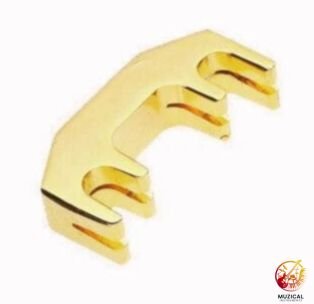
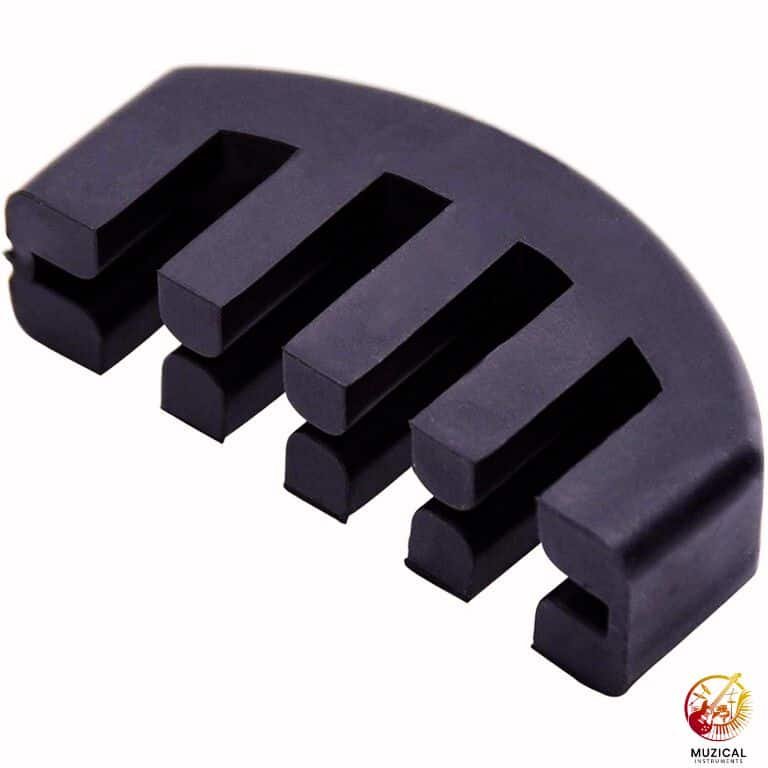
A rubber mute keeps more of your instrument’s natural feedback. You can still hear overtones, dynamics, and bow textures. That makes it easier to tell if your bow is skating, your finger placement is off, or your tone is too scratchy.
On the flip side, brass mutes can mask some of those details. They’re so effective at dampening sound that they also mute your mistakes. This can be useful if you’re focusing on left-hand work and don’t want sound to distract you. But it might not help if you’re trying to refine subtle phrasing or tone control.
Professional teachers often suggest using a rubber mute during technique work for this reason. It allows the student to keep the volume down while still developing musical expression.
Which Mute Affects Your Tone More: Brass or Rubber?
In the context of brass vs rubber violin mute performance, tone is everything. Even when you’re trying to be quiet, you still want to hear what makes your playing unique.
So here’s what happens:
| Mute Type | Tone Output | Warmth | Clarity | Overtones |
|---|---|---|---|---|
| Brass | Heavily reduced, darker | Low | Moderate | Almost none |
| Rubber | Moderately reduced | Medium | High | Some remain |
Brass mutes flatten your tone. They remove upper harmonics and make your violin sound more like a viola with a blanket over it.
Rubber mutes soften your tone. They leave more overtones intact, which helps your ears and fingers stay connected to your true sound.
This makes a rubber mute the better choice if you’re working on bowing styles, dynamic control, or shifting exercises.
Can Using the Wrong Mute Hurt Your Playing Over Time?
Yes, and not just a little.
Using a heavy mute (like brass) for every session can lead to:
- Reduced ear sensitivity (you stop hearing subtle pitch problems)
- Compensating with pressure (pressing harder to get sound out)
- Fatigue in right arm and hand (due to extra resistance)
Rubber mutes avoid most of these problems because they maintain enough responsiveness and tonal feedback to keep you honest.
Do These Mutes Affect the Life of Your Violin?
When discussing the topic of brass vs rubber violin mute safety, every violinist worries about damage, especially to the bridge. Can mutes harm your instrument over time?
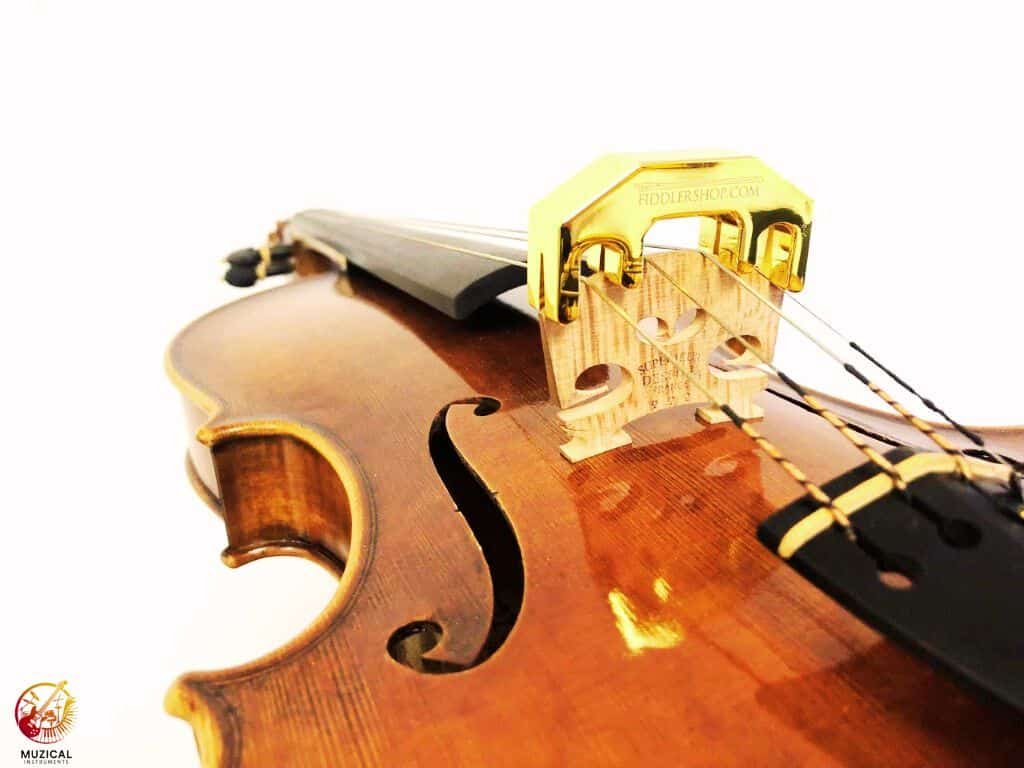
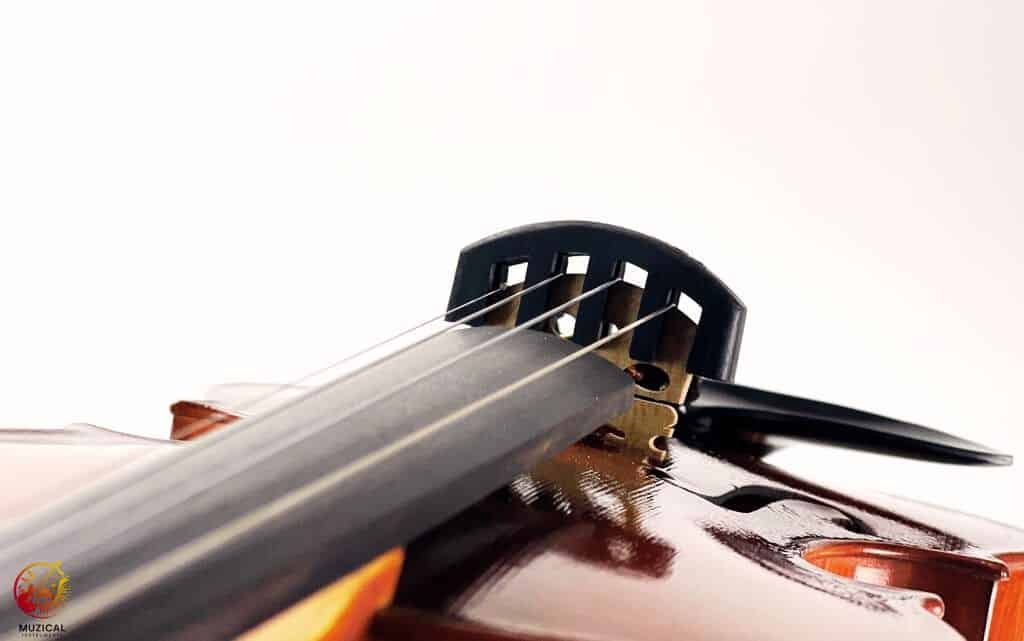
Rubber mutes are soft and flexible. They sit snugly over the bridge without scratching or denting. They’re gentle, especially for delicate older violins or fine setups.
Brass mutes? They’re solid and heavy. If placed carelessly, they can dent the bridge or even leave tiny marks. Some players report the mute slowly pressing the bridge forward or backward over weeks of use. That could affect your violin’s setup.
A good workaround? Line the inside of a brass mute with felt or silicone. It cushions the contact point and keeps the mute stable. Also, avoid dropping it onto the bridge. Always place it gently.
In short: rubber is safer. Brass is riskier, but manageable with care.
How Does Price and Portability Factor into Your Choice?
Most rubber mutes cost between $5 and $15, while brass mutes can range from $20 to $35 or more.
Rubber mutes are also easier to store. Many attach to the strings behind the bridge when not in use, so they’re always ready.
Brass mutes, being bulky and heavy, must be stored separately. And if you’re carrying your violin on a bus, train, or plane, that matters.
So if you value ease of use and portability, the rubber mute is the obvious winner.
Are There Hybrid or Alternative Mutes Worth Trying?
Yes, some brands now offer composite mutes that try to balance the tone-dampening power of brass with the safety and feel of rubber.
Examples include:
- Ultra Practice Mutes: Rubber-like material but thicker for more damping
- Metal-Rubber Hybrids: Brass core wrapped in soft exterior
- Magnetic Mutes: Attach easily without damaging the bridge
These give you options if you want moderate quietness with tone preservation. They cost more, but for some players, they offer the best of both worlds.
Final Verdict: Brass vs Rubber Violin Mute : Which Is Better for Practice?
Let’s wrap it up clearly.
| Criteria | Brass Mute | Rubber Mute |
|---|---|---|
| Volume Reduction | Very High | Medium |
| Tone Preservation | Low | High |
| Ear Training | Poor | Good |
| Daily Practice Use | Not ideal | Excellent |
| Bridge Safety | Risk of damage | Safe |
| Portability | Bulky | Convenient |
| Price | Higher | Lower |
Use brass mutes for extreme silence when you absolutely must stay quiet. Think hotel rooms, shared sleeping spaces, or baby nap time.
Use rubber mutes for everything else, especially focused practice sessions where tone, technique, and ear development matter.
Final Thoughts
Brass vs rubber violin mute: both have their place. Brass gives you serious volume control for sensitive spaces. Rubber lets you mute softly without sacrificing tone or technique.
If you’re new to muted practice, start with a rubber mute. It’s safer, cheaper, and easier on your tone. Move to brass if you need near-silent playing or want to work on left-hand drills without distractions.
So, which one is better? That depends on your practice goals, your living situation, and your sound preferences. Try both if you can. Your ears and neighbors will thank you.
Before choosing your mute, it’s also helpful to understand the difference between a fiddle and a violin, since your playing style may affect your choice.
Frequently Asked Questions: Brass vs Rubber Violin Mute
1. Which mute is better for beginners?
Rubber mutes are better for beginners. They’re lighter, safer, and let you hear more of your real tone. That matters when you’re learning finger placement, bow control, and ear training. Using a heavy brass mute too early can mask mistakes and lead to bad habits.
2. Can a rubber mute stay on the violin when not in use?
Yes. Most rubber mutes are designed to rest behind the bridge, clipped onto the strings when not active. This makes them super convenient for quick practice sessions. Just slide it forward when you need it, and back when you don’t. This feature is a big reason why rubber mutes are more user-friendly than brass ones.
3. Do professional violinists use brass or rubber mutes?
Professional violinists typically use both rubber mutes for practice and rubber or metal performance mutes (like a Tourte) for orchestral work. Brass mutes are usually reserved for special cases where maximum volume reduction is needed (like practicing in a hotel room). Even pros avoid overusing brass mutes because of their tone-dampening effect.
4. How much quieter is a brass mute compared to a rubber one?
A brass mute can reduce your violin’s volume by up to 70%, while a rubber mute typically reduces it by 20% to 40%. If you need to practice late at night or in thin-walled apartments, a brass mute is better for quiet but if you want tone clarity and ear training, rubber is far superior.
5. Is there a mute that combines the best of both?
Yes. Some brands make hybrid or composite practice mutes like the Ultra Practice Mute that offer a middle ground. These are often made of dense rubber or synthetic material and reduce sound more than a standard rubber mute but less than brass. They’re a solid option if you want better silence without completely losing tonal feedback.
6. Can violin mutes affect your bowing technique?
Definitely. A heavy mute like brass adds resistance and changes how the bow feels on the strings. This can lead to tension or compensation if overused. Rubber mutes, being lighter, have less of an impact but still change the response slightly. That’s why it’s important to balance muted and unmuted practice.
7. Does a brass mute damage your violin?
It can, especially over time. Brass mutes are heavy and rigid. If they’re dropped or placed carelessly, they may dent the bridge or leave marks on the varnish. They also put more pressure on the bridge, which isn’t ideal for delicate or older instruments. If you use a brass mute, always place and remove it gently and never leave it on for long periods.
